SUNNY CAL JOURNAL - Whip Wilson, Nyoka The Jungle Girl And Frozen Custard, Memories Of The Kanawha
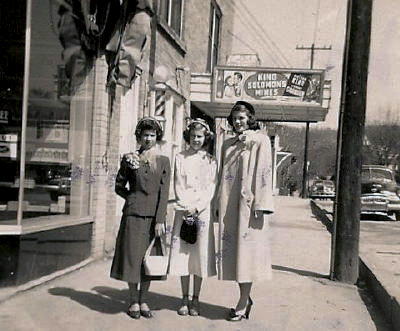
Grantsville girls (left-right) Beverly Cain, Charlotte
Campbell and JoAnn Campbell (Stump) all dressed up on
Main Street at the Kanawha, showing 1950's "King Solomon's Mines" (Bob Weaver Collection)
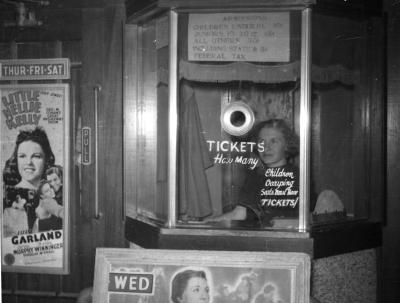
Eva Carpenter selling Kanawha movie house tickets
(10-30 cents) in early 1940s (David Hathaway Photo)
By Bob Weaver
I suppose today's crop of kids will treasure their memories of Facebook posts, MTV reruns, Mortal Kombat, The Simpsons, video games, personal communication devices and a million things bamboozled by the web.
From my generation, I believe treasured memories are more important because of their scarcity.
There was scarce media entertainment in Sunny Cal over seventy years ago, beyond Saturday morning radio, Big John and Sparky or Let's Pretend, or the evening programs like Superman leaping tall buildings with a single bound.
The Shadow, "who always knows," and the Lone Ranger riding out of town with someone always asking, "Who was that masked man?"
And we had a few scratchy 78 rpm records, and those exciting new 45's with the big hole in the middle.
But most importantly we had the Kanawha Theatre, owned and delicately operated by John and Helen Cook, who established the movie house in the late 1930s. It was Grantsville's second movie house, after the silent movie era.
John would invite the entire Grantsville Grade School to movies he thought kids would like, and they would march single file down High Street to the picture show on Main Street.
They paid what they could, a nickel or dime if they had it. If they didn't, it was all right.
I remember seeing the Gregory Peck film, "The Yearling," right after WWII, as a member of Ms. Thelma Stump's first grade.
Back at the school house we had the "Movie of the Month," usually ESSO travel films with women kissing the heads of dangerous boa's, or trips through the Amazon rain forests.
John was a great promoter, and he really took pride in his movie business. He would often come out and say a few words before the feature began, or later at his drive-in movie, he would get on the speaker system and welcome you, like an invited guest.
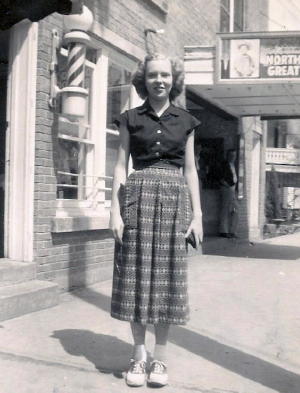
"Proxie" Poling posing in front of the Kanawha,
on Grantsville's Main Street (Bob Weaver Collection)
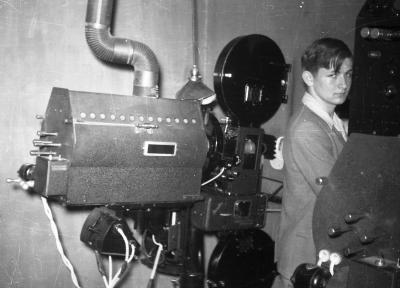
Forest Gunn in the Kanawha projection booth
about 1942, bright images on the silver screen
illuminated by a carbon arc (David Hathaway Photo)
It was the anticipation of getting another twenty cents to go to the Kanawha that stirred the mind at bedtime. Matinees on Saturday, sometimes two showings every night of the week.
Sometimes you couldn't get a seat. Saturday was the big kid's day, with a western, newsreel, cartoons, and the ever exciting cliff-hangers, the fifteen chapter serials.
Roy Rogers, Gene Autry, Lash LaRue, Charles Starrett as the Durango Kid, Rex Allen, Randolph Scott, and Whip Wilson.
What do you mean you've never heard of Whip Wilson? I touched his hand one Saturday evening right there in the crowded Kanawha, when he came down from the stage and passed out his autographed pictures.
He flipped and cracked his whip a few times, picked and sang a cowboy song, and then we all settled back to watch his adventures on the big screen.
The serials would bring you back, with total recall of last week's near death experience, a stagecoach crashing over a rock cliff or Superman losing his powers to the bad guy with Kryptonite, all of them to mystically pass through the needle of survival and live again for another fifteen minutes.
I can still see the faces of the B-playing character actors who made the likes of Undersea Kingdom, based on Jules Verne's story, Batman and Robin, Rocketman, Superman, and Tarzan.
Most memorable was Nyoka, the Jungle Girl, a female Tarzan-type with leopard loin cloth and a white satin bra that glistened as she swung from tree to tree.
How could you forget that.
Of course there was the popcorn and soft drinks, in the early days not more than ten cents each. The big hit was soft ice cream, first introduced to Sunny Cal by Cook and sold as "frozen custard."
I thought I would never get my fill, and one time I ate four cones.
It was there that I saw "Gone With The Wind" for the first time with my dad and mom, and the first wide screen movies - Cinemascope, with Robert Mitchum and Marilyn Monroe in "River of No Return," and Elvis Presley in "Love Me Tender."
John Cook knocked the walls down on either side of the pint-sized screen and installed the largest wide screen I had ever seen.
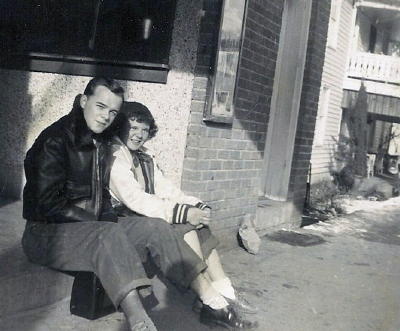
Going to the Kanawha was the most prevalent dating
opportunity in the 1950s, shown here Delmar Siers and Jeannie Smith
(Pollock) waiting to go to the movies(Bob Weaver Collection)
Sunday and Monday they showed more refined movies, Esther Williams swimming, Fred Astaire dancing, all those great MGM pageants.
Bill Harris of Grantsville, was the last of the old time movie projectionists. He said the big 35mm Simplex projectors, illuminating the screen with their carbon arcs, would make the tiny booth get sweating hot as he switched from reel to reel, staring through the tiny window, adjusting the picture and sound.
"One time my knee hit the volume control on the amplifier just as a train was coming down the tracks. The volume went from seven to twelve, and the first four rows fell backward," he said.
The old equipment produced a brilliant and sharp image on the silver screen, much better than the postage stamp movies in the mall. It was a delight.
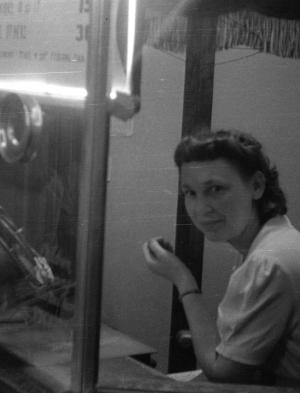
Helen Cook, wife of owner John Cook, selling
tickets in early 1940s (David Hathaway Photo)
John and Helen went out to Mt. Zion in 1952 to put up the first drive-in movie in the area,it was among the last drive-in movies in America.
The old Kanawha lasted about a year after the drive-in opened, as TV kept folks home watching wrestling and "Saturday Night at the Movies."
Before the movie business got bad, John and Helen, now both long gone, sold out and went to operate the lodge at Blackwater Falls, and later one of Parkersburg's finer hotels.
But the old movie house was their labor of love, which they extended to kids and parents who fired up the family car or caught the neighbor's truck, coming from every holler in the county to spend a couple hours marveling at the glory of a greater world.
Arnoldsburg and Orma once had movie houses of their own.
How could one be bored, just thinking about going back to the movies one more time.
2000